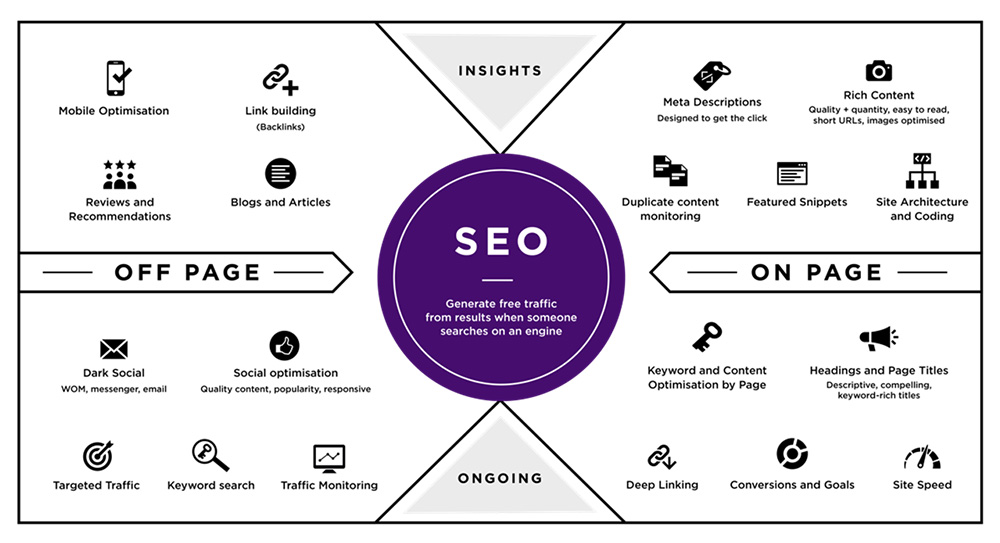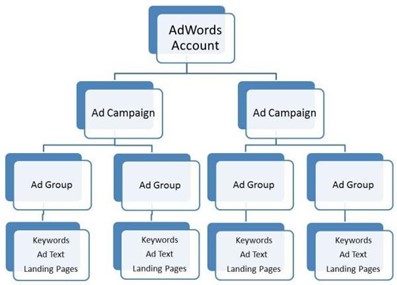By Valentina Borbone
Search marketing is full of three-letter acronyms. Two of the most important are SEO and SEM. But what do they mean and what’s the difference? Here’s what you need to know about search marketing and how to gain traffic and visibility from search engines through both unpaid and paid efforts.
SEO
SEO stands for Search Engine Optimisation. It’s an organic, unpaid approach to search marketing and helps position websites within Search Engine Results Pages (SERP’s). Where your website is positioned or ranked on these SERP’s is determined by how well your website, social profiles and online presence is optimised with the keywords people are searching to find your services.
Google has roughly 200 ranking factors in its algorithm, making up an index of the entire internet. And this algorithm is always changing, which means SEO is not a ‘set and forget’ task. It’s certainly not a case of simply building a website, sitting back and then waiting for the traffic to come. SEO is ongoing, complex and forever changing.
On-page SEO
On-page SEO is the practice of optimising individual web pages in order to rank higher and earn more relevant traffic in search engines. It relates to both the content and source code of a web page that can be optimised (as opposed to off-page SEO, which refers to links and other external signals).
Most on-page activity is related directly to the coding and keywords used when building your website and pages. This means ensuring your content is original, the right descriptions are in place, keywords are used and links are embedded throughout the website.
Unfortunately, many websites are built without SEO in mind. Then there are those website developers who will charge extra for SEO, which is like selling a car without the engine. If your website isn’t optimised, it’s simply not going to be found by your potential customers.
There are only a finite number of positions on page one of Google’s search results. Remember, your competitors are competing for the same positions that you are, so you need to have better SEO practices in place than your competitor to rank higher.
Off-page SEO
Off-page SEO refers to all of the activities that you and others do off your website to raise the ranking of a web page with search engines. For example, if you write a guest post for a blog on another website or leave a comment in response to a piece of content, you’re doing off-page site promotion.
Links are important to Google. Brand mentions (that is, your website URL or brand name mentioned on another website without a hyperlink) are an integral aspect of off-page search signals. If you have a lot of valuable links pointing to your pages, search engines will assume that you’ve got great content. Great content provides value for users and will be rewarded by Google with better search rankings.
Health Check
There are many SEO tools available. For a quick health check of your website and a great report for free, go to seositecheckup.com. Just pop in your URL to see a speedometer that gives you a ranking out of 100. If your score is 80 or over, you're doing very well.
The downloadable report can be sent straight to your website developers. The report is a traffic light system, with red failed remarks, amber warnings and green success. The report also includes links to definitions of what’s wrong and also instructions on how to fix it.
Start with SEO
Any search marketing effort has to start with an organic approach and getting your SEO in order. Make sure your website’s content and links to your website are reflective of the search terms you want to rank for within search engines. Also, be sure to meet the requirements of a bunch of other aspects of the algorithm. Once this is done, you can start thinking about a paid, SEM approach.

SEM
SEM stands for Search Engine Marketing. It refers to purchasing the results displayed at the top of Search Engine Results Pages (SERP’s) and other ad real estate across the internet. It’s commonly known as ‘paid search’ or PPC (pay per click). Search engines, such as Google, charge you per click on the paid search ad you create. You might know this as Google AdWords. They’re now just called Google Ads, and yes, you can buy these on Bing too.
Advertisers bid on keywords that consumers might enter when looking for certain products or services, which gives the advertiser the opportunity for their ads to appear alongside results for those search queries.
These ads come in a variety of formats. Some are small, text-based ads. Others, such as product listing ads (also known as shopping ads), are more visual, product-based advertisements that allow consumers to see important information at-a-glance, such as price and reviews.
Logical keyword grouping and account structure can help you achieve higher click-through rates and a lower cost per click.
Ad groups allow for each campaign to be further subcategorised for relevance. For example, one ad group could be about appraisals and another could be about auctions.
Ad auctions
The ad auction process takes place every single time someone enters a search query into Google. If Google determines that the keywords you’ve bid on are contained within a user’s search query, your ads are entered into the ad auction. Not every single ad will appear on every single search, because the auction takes a variety of factors into account when determining the placement of ads on the SERP.
Google evaluates two main parts of the ad auction process: your maximum bid and the Quality Score of your ads.
The Quality Score is Google's rating of the quality and relevance of both your keywords and PPC ads. It’s used to determine your cost per click (CPC) and multiplied by your maximum bid to determine your ad rank in the ad auction process. Your Quality Score algorithm includes:
- Your click-through rate
- The relevance of each keyword to its ad group
- Landing page quality and relevance
- The relevance of your ad text
- Your historical Google Ads account performance.
Quality Scores correlate with lower cost per conversion. A high Quality Score is Google's way of saying that your PPC ad meets your potential customers’ needs. The better you are at meeting the customer’s needs, the less Google will charge you for the ad click.
SEM’s greatest strength is that it offers advertisers the opportunity to put their ads in front of motivated customers who are ready to buy at the precise moment they’re ready to transact.

Valentina Borbone is the Founder and CEO of Banter Group.